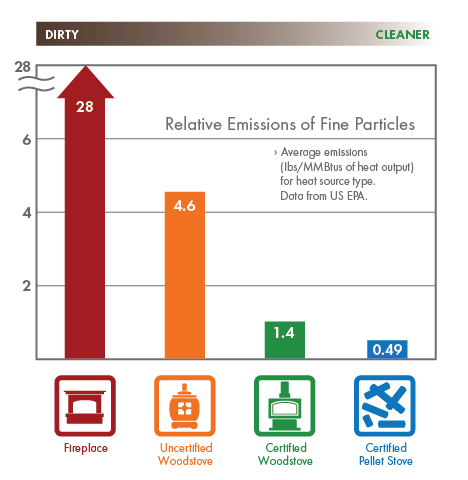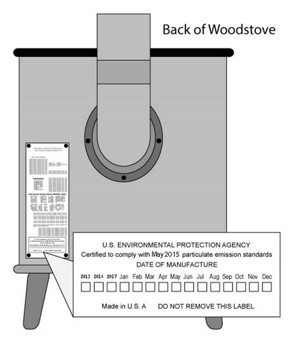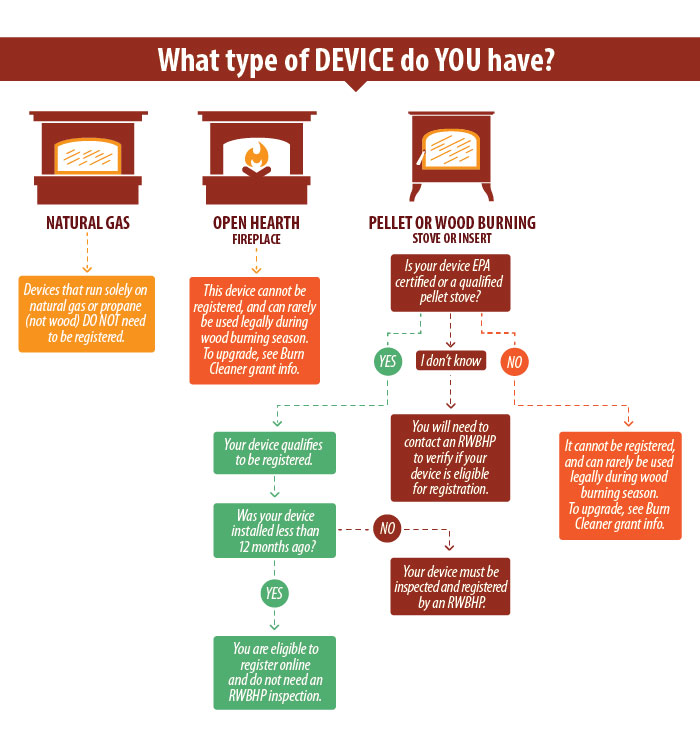Residential Wood Burning Rule 4901
District Rule 4901 and the associated Residential Wood Smoke Reduction Program help reduce fine-particulate matter (PM2.5) when winter air quality is forecast to deteriorate. Achieving additional emissions reductions from residential wood burning is necessary for the Valley to meet federal PM2.5 health standards and improve public health.
Burn Cleaner Incentive Program
The District’s Burn Cleaner Program plays a key role in transitioning older wood burning devices to cleaner devices and works closely with Valley communities and retail partners to implement the program. For areas in the counties of Madera, Fresno, and Kern that have access to natural gas, the District is increasing incentive amounts for residents wishing to upgrade their devices to cleaner alternatives.
Apply for Burn Cleaner Program Contracted Retailers
Episodic Wood Burning Curtailments

Proper Operation of Wood Burning Fireplace and Heaters
- Anyone operating a registered wood burning fireplace or heater must ensure there is no visible smoke year-round (except when a fire is started). Startup of a new fire may not exceed 15 consecutive minutes in any consecutive four-hour period.
- Anyone operating a wood burning fireplace or a wood burning heater must ensure the visible emissions do not exceed 20% opacity for a period or periods aggregating more than three (3) minutes in any one (1) hour.
Health Impacts of Wood Smoke
What are the adverse impacts? Reducing emissions from residential wood burning is a high priority for the District, as multiple scientific studies show that prolonged inhalation of wood smoke has adverse impacts on human health. Prolonged inhalation of wood smoke contributes to lung disease, pulmonary arterial hypertension, and pulmonary heart disease, which can eventually lead to heart failure. Wood smoke has also been linked to oxidative stress and blood coagulation and can ultimately lead to cancer. Children with the highest exposure to wood smoke show a significant decrease in lung function.
Who does wood smoke effect? Residents can be exposed to wood smoke inside their homes when they use their wood burning devices. Additionally, residents can be exposed to wood smoke when neighbors use wood burning devices due to smoke infiltration into homes nearby.
Health Risks of Wood Smoke and COVID-19 Please visit this EPA resource for more information.
What are the differences in smoke impacts among the various wood burning devices?

Selling or Transferring a Home
What are the requirements? At the time of sale or transfer of a home, any wood burning heater located at the residential property is required to meet EPA certification or be a pellet-fueled wood burning heater that was exempt at time of purchase/installation. Otherwise, the wood burning heater(s) must be rendered permanently inoperable and removed from property.
How do I comply with the rule requirements?
Seller of the home must permanently render inoperable and remove from property any wood burning heater, insert, or stove that does not meet EPA certification. Seller is required to submit verification of compliance to the buyer and the District within 30 days of close of escrow.
statement of compliance
Upload Statement of Compliance below
What is a certified device? A device that meets emissions performance standards test. It generates less smoke (fewer particles) than a non-certified stove and uses less wood to create more heat.
How do I determine EPA certification? To determine if your heater is in compliance, check the owners’ manual or the retail store where you purchased the stove. An EPA-certified wood stove also can be identified by a temporary paper label attached to the front of the stove and a permanent, metal label on the back or side (see below for example). If the label is missing or inaccessible, the EPA maintains a database of certified stoves at: EPA Certified Wood Heater Database
What devices can be left in the home? Fireplaces, stoves or inserts manufactured to meet EPA emissions performance standards or exempt, and fueled exclusively by natural gas, propane, or electric.
How do I permanently render inoperable and remove the non-certified device from the property? We encourage you to contact a chimney sweep or hearth products dealer in your area. The District provides a list of hearth retailers through the Burn Cleaner incentive program.
Are there any exemptions to this requirement? It applies to all real estate transactions within the jurisdiction of the Valley Air District. This includes real estate owned by banks or other financial institutions (known as REO properties)
What does the permanent label on an EPA-certified wood stove look like?

Where can I get help to identify whether my wood burning heater is EPA-certified? We encourage you to contact a hearth products dealer who the District has been coordinating this effort with. The District provides a list of hearth retailers (link can be found under support materials) through the Burn Cleaner incentive program.
Where can I get more information? Please contact the District.
Installation Restrictions of New Wood Burning Fireplaces and Heaters
| Location | Restrictions |
|---|---|
| Areas below 3,000 feet elevation with natural gas service | No installation of wood burning fireplaces, low mass fireplace, masonry heater, or wood burning heaters |
| Areas at or above 3,000 feet elevation or areas without natural gas service | No installation of wood burning fireplaces or non-EPA-certified wood burning heaters No installation of more than two EPA certified wood burning heaters per acre (limited to one per dwelling unit) |
Remodeling of Fireplaces
Anyone making a modification to a fireplace or chimney that impacts the physical structure of the fireplace or chimney must install an EPA certified, gas-fueled, or electric device if:
- Cost of fireplace remodel exceeds $15,000, and
- Building permit application for the modification is submitted after January 1, 2020
Aesthetic modifications that do not affect the physical structure of the fireplace are not subject to this requirement, i.e. installing decorative stone/tile in front of fireplace.
Remodeling and New Installations Flyer: English ESPAÑOLDevice Registration
To register a device, it must be a pellet insert/freestanding stove or an EPA- certified wood stove/insert/heater. Check the chart below to determine if you have a qualifying device. If your device does not qualify, you can take advantage of our Burn Cleaner incentive program to purchase a cleaner device.
 Apply for Burn Cleaner Program
Register Your Device
Apply for Burn Cleaner Program
Register Your Device
Publications and Media
Media Images



News Release
Print Media
- Check Before You Burn: English Spanish
- Device Registration Brochure
- Wood Burning Infographic
Commercials
Resources
- Report a Wood Burning Violation
- Request a Residential Exemption
- Rule 4901 – Woodburning Fireplaces and Woodburning Heaters
- Rule 3901 - Fees for Registration of Wood Burning Heaters
- Register My Residential Wood Burning Device
- Training Workshop Flyer - Registered Wood Burning Heater Professional
- Application for Wood Burning Heater Professionals
- Contact a Registered Wood Burning Heater Professional
- Wood Burning Devices at Christmas Tree Lots
Additional Resources
